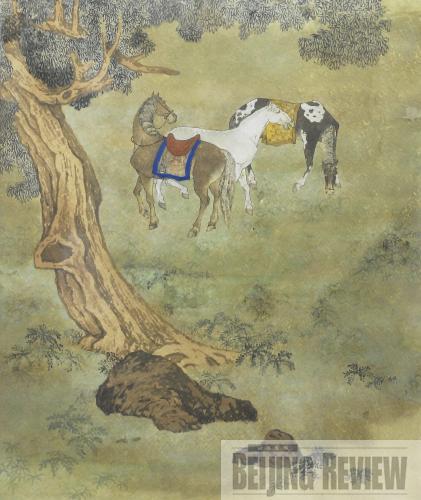|
 |
|
Three Horses (1950) (WEI YAO) |
Tseng uses a lot of lines in her work, something that is very common in Chinese art. "More and more Western artists tend to adopt lines in their work now," Tseng said, adding that in her eyes, lines have important aesthetic value and can express deep meanings.
The mastery of both Chinese and Western art gave Tseng great space to develop her own style. In her early years, she experimented with a technique she developed, called Zhui Hua, a kind of art form similar to Western collage. Absorbing the traditional techniques in China of mounting Chinese paintings, she assembled disparate pieces of paper to produce a new effect.
In Tseng's later works, she mixed Chinese art with modern Western art. The colors and images in her paintings combine in an almost lyrical way.
Young at heart
Tseng impresses everyone who knows her with her passion both in art and in life. Looking much younger than her age, and with all her faculties intact, Tseng is alert and youthful in spirit.
She believes it is her curiosity about the world around her and the eternal pursuit of beauty that keep her young.
"I like to know what young people are interested in and love to understand the new world," she said. Besides painting and calligraphy, she is also fond of movies, music and anything in which she can find aesthetic value.
"There is a general law in all forms of art," she said, "and the emotion or feeling in appreciating other forms of art gives me great inspiration."
Rich experience
In 1925, Tseng was born to an educated and modern-thinking family in Beijing. Since childhood, she had been captivated by the joy of writing and painting. At 17, she graduated from the Art Department of Furen University in Beijing, a Catholic higher education institution founded in 1925. It was there that she learned traditional Chinese painting and calligraphy from masters such as Qi Gong and Rong Geng. After graduation, she worked as an assistant to Professor Gustav Ecke, an art historian, who later became her husband.
Professor Ecke was the first person to introduce China's Ming Dynasty (1368-1644) furniture to the rest of the world. His book Chinese Domestic Furniture in Photographs and Measured Drawings, written in 1944, still carries weight in today's research on China's Ming Dynasty furniture.
In 1949, Tseng and her husband left China to live in Hawaii. She received her master's degree in arts at the University of Hawaii, and then a PhD from the Fine Arts Institute of New York University.
Tseng has devoted her whole life to art and education. From 1969 to 1998, she worked as a professor at the University of Hawaii, teaching Chinese painting and the history of Chinese fine arts. She was also appointed assistant curator at the Honolulu Academy of Arts.
| 